分词的功能和独立主格结构
- 格式:doc
- 大小:77.51 KB
- 文档页数:8
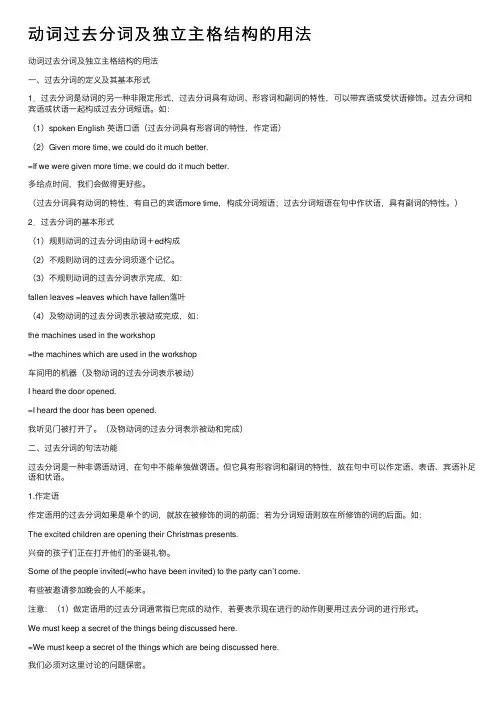
动词过去分词及独⽴主格结构的⽤法动词过去分词及独⽴主格结构的⽤法⼀、过去分词的定义及其基本形式1.过去分词是动词的另⼀种⾮限定形式,过去分词具有动词、形容词和副词的特性,可以带宾语或受状语修饰。
过去分词和宾语或状语⼀起构成过去分词短语。
如:(1)spoken English 英语⼝语(过去分词具有形容词的特性,作定语)(2)Given more time, we could do it much better.=If we were given more time, we could do it much better.多给点时间,我们会做得更好些。
(过去分词具有动词的特性,有⾃⼰的宾语more time,构成分词短语;过去分词短语在句中作状语,具有副词的特性。
)2.过去分词的基本形式(1)规则动词的过去分词由动词+ed构成(2)不规则动词的过去分词须逐个记忆。
(3)不规则动词的过去分词表⽰完成,如:fallen leaves =leaves which have fallen落叶(4)及物动词的过去分词表⽰被动或完成,如:the machines used in the workshop=the machines which are used in the workshop车间⽤的机器(及物动词的过去分词表⽰被动)I heard the door opened.=I heard the door has been opened.我听见门被打开了。
(及物动词的过去分词表⽰被动和完成)⼆、过去分词的句法功能过去分词是⼀种⾮谓语动词,在句中不能单独做谓语。
但它具有形容词和副词的特性,故在句中可以作定语、表语、宾语补⾜语和状语。
1.作定语作定语⽤的过去分词如果是单个的词,就放在被修饰的词的前⾯;若为分词短语则放在所修饰的词的后⾯。
如:The excited children are opening their Christmas presents.兴奋的孩⼦们正在打开他们的圣诞礼物。
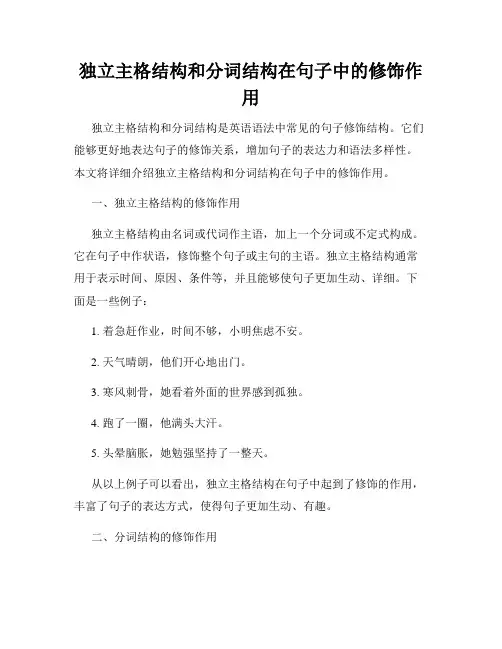
独立主格结构和分词结构在句子中的修饰作用独立主格结构和分词结构是英语语法中常见的句子修饰结构。
它们能够更好地表达句子的修饰关系,增加句子的表达力和语法多样性。
本文将详细介绍独立主格结构和分词结构在句子中的修饰作用。
一、独立主格结构的修饰作用独立主格结构由名词或代词作主语,加上一个分词或不定式构成。
它在句子中作状语,修饰整个句子或主句的主语。
独立主格结构通常用于表示时间、原因、条件等,并且能够使句子更加生动、详细。
下面是一些例子:1. 着急赶作业,时间不够,小明焦虑不安。
2. 天气晴朗,他们开心地出门。
3. 寒风刺骨,她看着外面的世界感到孤独。
4. 跑了一圈,他满头大汗。
5. 头晕脑胀,她勉强坚持了一整天。
从以上例子可以看出,独立主格结构在句子中起到了修饰的作用,丰富了句子的表达方式,使得句子更加生动、有趣。
二、分词结构的修饰作用分词结构是由分词及其修饰成分构成的结构,它可以在句子中作状语、定语或补语。
分词结构通常用于描述句子的主语,表示时间、原因、方式等。
下面是一些例子:1. 坐在沙发上,她看着电视。
2. 吵闹的街道上,行人匆匆而过。
3. 热气腾腾的汤,散发着诱人的香味。
4. 走在泥泞的小道上,他们的鞋子沾满了泥巴。
5. 通过努力学习,他们终于获得了优秀的成绩。
从以上例子可以看出,分词结构能够在句子中起到修饰主语的作用,丰富了句子的表达方式,使得句子更加具体、生动。
总结:独立主格结构和分词结构在句子中的修饰作用是非常重要的,它们能够使句子更加完整、丰富。
通过运用独立主格结构和分词结构,我们可以更好地表达句子的修饰关系,使得句子更有层次感、更具有语法多样性。
在写作中,我们应该灵活运用独立主格结构和分词结构,提高句子的表达能力和语法水平。
另外,我们需要注意在运用独立主格结构和分词结构时,要保持语句的通顺和整洁美观。
避免句子过于复杂或使用过多的修饰结构,以免影响读者的阅读体验。
最后,我们应该根据具体的语境和写作需求来选择合适的修饰结构,使得句子更具有说服力和表现力。
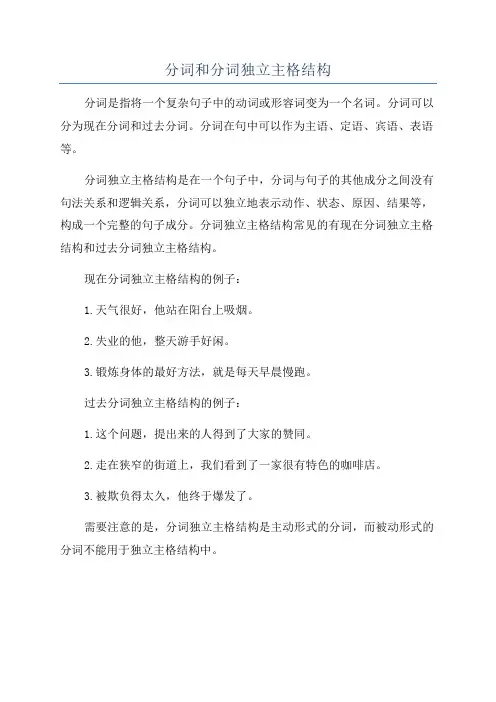
分词和分词独立主格结构
分词是指将一个复杂句子中的动词或形容词变为一个名词。
分词可以分为现在分词和过去分词。
分词在句中可以作为主语、定语、宾语、表语等。
分词独立主格结构是在一个句子中,分词与句子的其他成分之间没有句法关系和逻辑关系,分词可以独立地表示动作、状态、原因、结果等,构成一个完整的句子成分。
分词独立主格结构常见的有现在分词独立主格结构和过去分词独立主格结构。
现在分词独立主格结构的例子:
1.天气很好,他站在阳台上吸烟。
2.失业的他,整天游手好闲。
3.锻炼身体的最好方法,就是每天早晨慢跑。
过去分词独立主格结构的例子:
1.这个问题,提出来的人得到了大家的赞同。
2.走在狭窄的街道上,我们看到了一家很有特色的咖啡店。
3.被欺负得太久,他终于爆发了。
需要注意的是,分词独立主格结构是主动形式的分词,而被动形式的分词不能用于独立主格结构中。
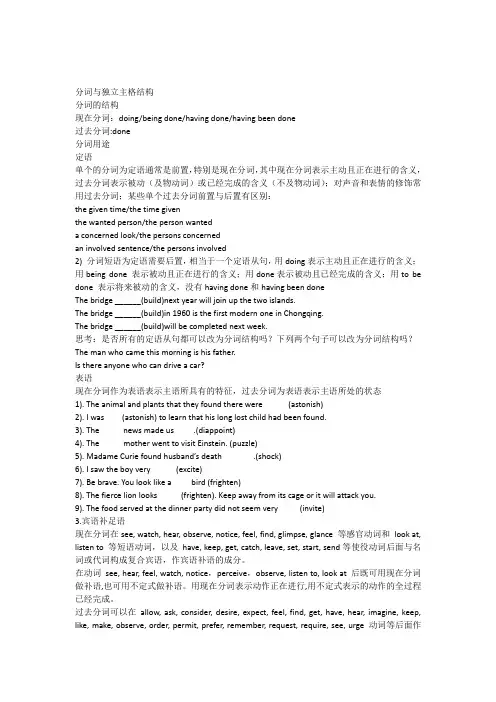
分词与独立主格结构分词的结构现在分词:doing/being done/having done/having been done过去分词:done分词用途定语单个的分词为定语通常是前置,特别是现在分词,其中现在分词表示主动且正在进行的含义,过去分词表示被动(及物动词)或已经完成的含义(不及物动词);对声音和表情的修饰常用过去分词;某些单个过去分词前置与后置有区别:the given time/the time giventhe wanted person/the person wanteda concerned look/the persons concernedan involved sentence/the persons involved2) 分词短语为定语需要后置,相当于一个定语从句,用doing表示主动且正在进行的含义;用being done 表示被动且正在进行的含义;用done表示被动且已经完成的含义;用to be done 表示将来被动的含义,没有having done和having been doneThe bridge ______(build)next year will join up the two islands.The bridge ______(build)in 1960 is the first modern one in Chongqing.The bridge ______(build)will be completed next week.思考:是否所有的定语从句都可以改为分词结构吗?下列两个句子可以改为分词结构吗?The man who came this morning is his father.Is there anyone who can drive a car?表语现在分词作为表语表示主语所具有的特征,过去分词为表语表示主语所处的状态1). The animal and plants that they found there were (astonish)2). I was (astonish) to learn that his long lost child had been found.3). The news made us .(diappoint)4). The mother went to visit Einstein. (puzzle)5). Madame Curie found husband’s death .(shock)6). I saw the boy very (excite)7). Be brave. You look like a bird (frighten)8). The fierce lion looks (frighten). Keep away from its cage or it will attack you.9). The food served at the dinner party did not seem very (invite)3.宾语补足语现在分词在see, watch, hear, observe, notice, feel, find, glimpse, glance 等感官动词和look at, listen to 等短语动词,以及have, keep, get, catch, leave, set, start, send等使役动词后面与名词或代词构成复合宾语,作宾语补语的成分。
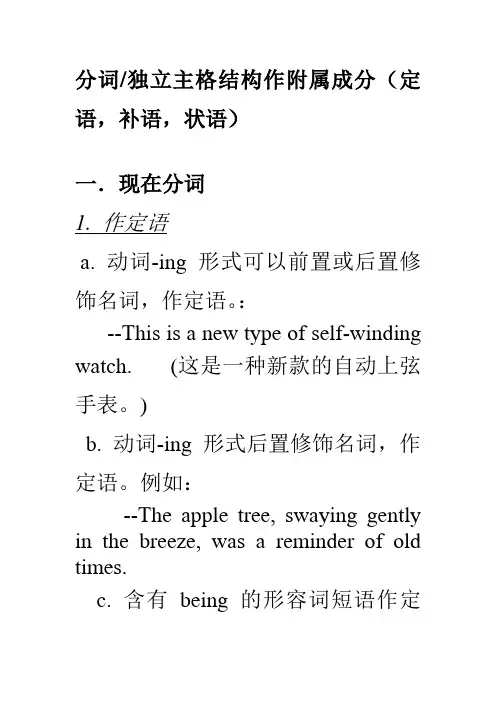
分词/独立主格结构作附属成分(定语,补语,状语)一.现在分词1. 作定语a. 动词-ing形式可以前置或后置修饰名词,作定语。
:--This is a new type of self-winding watch. (这是一种新款的自动上弦手表。
)b. 动词-ing形式后置修饰名词,作定语。
例如:--The apple tree, swaying gently in the breeze, was a reminder of old times.c. 含有being的形容词短语作定语,只能表示被动进行。
如:--Did you see that boy being questioned by the police? (你看到那个正在受警察盘问的男孩了吗?)2. 作状语a. 动词-ing形式作状语相当与各类副词从句--She begged him not to drink too much, reminding him that he'd have to drive home.(表示进一步说明)--Frankly speaking, I don't like people of his kind. (表示方式)--Putting down the newspaper, I walked over the window and looked out. (表示时间)--Not knowing what to do, the woman telephoned the police. (表示原因)--If going there by plane, we’ll have to pay twice as much. (表示条件)3.相当于状语从句的垂悬结构--Generally/broadly speaking, men can run faster than women.--Relatively speaking, the cost of living has remained static for several years.--She looks wonderful, considering she has been through so much.--Judging from his expression, he's in a bad mood.二.过去分词1. 定语a作前置定语--a born musician (= a natural musician)--a newly-born child--a married man (= a man who is married)--a recently-married womanb. 作后置定语---- the army defeated by the enemy, the army defeated for lack of ammunition.----the sum agreed upon----the people concerned (和所发生的事有关联的人)2. 作补语(as complement)a. 作主语补语----The quarrel of the night before seemed forgotten.b. 作宾语补语---They discovered him worn out by travel and exertion.3 相当于状语从句(as adverb clause equivalent)a. 动词-ed短语可以相当于副词短语,在句中作状语。
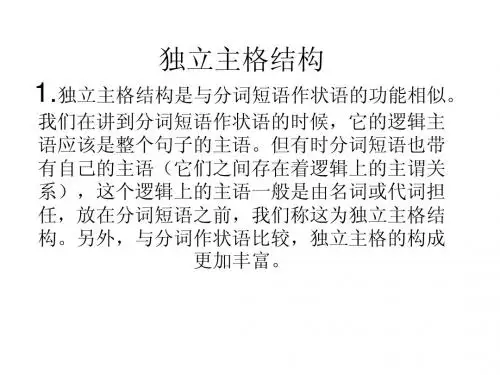
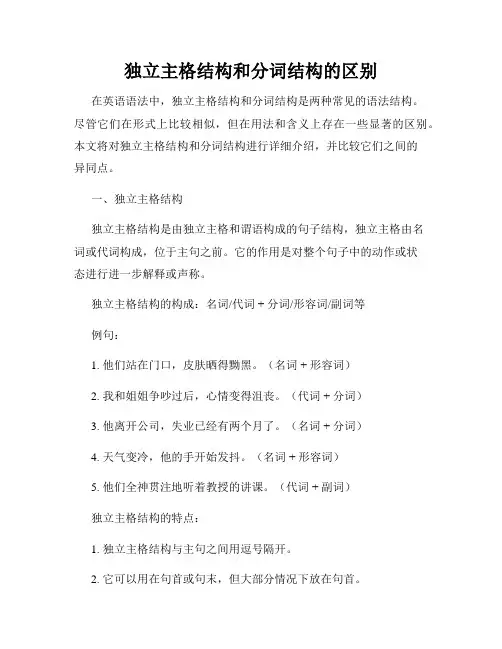
独立主格结构和分词结构的区别在英语语法中,独立主格结构和分词结构是两种常见的语法结构。
尽管它们在形式上比较相似,但在用法和含义上存在一些显著的区别。
本文将对独立主格结构和分词结构进行详细介绍,并比较它们之间的异同点。
一、独立主格结构独立主格结构是由独立主格和谓语构成的句子结构,独立主格由名词或代词构成,位于主句之前。
它的作用是对整个句子中的动作或状态进行进一步解释或声称。
独立主格结构的构成:名词/代词 + 分词/形容词/副词等例句:1. 他们站在门口,皮肤晒得黝黑。
(名词 + 形容词)2. 我和姐姐争吵过后,心情变得沮丧。
(代词 + 分词)3. 他离开公司,失业已经有两个月了。
(名词 + 分词)4. 天气变冷,他的手开始发抖。
(名词 + 形容词)5. 他们全神贯注地听着教授的讲课。
(代词 + 副词)独立主格结构的特点:1. 独立主格结构与主句之间用逗号隔开。
2. 它可以用在句首或句末,但大部分情况下放在句首。
3. 独立主格中的名词或代词通常是指句子主语的人或事物。
4. 独立主格结构不会影响句子的主谓结构。
二、分词结构分词结构是由分词(动词的现在分词或过去分词形式)加上修饰成分构成的结构。
它可以修饰名词或代词,表示该名词或代词的状态、特征或所处的位置等。
分词结构的构成:分词 + 修饰成分例句:1. 我看到他走在街上。
(现在分词)2. 这是我买的新书。
(过去分词)3. 坐在那里的女孩是我的朋友。
(现在分词)4. 穿着红色连衣裙的是我的姐姐。
(现在分词)5. 坐在教室后排的学生都很安静。
(现在分词)分词结构的特点:1. 分词结构修饰前面的名词或代词,起形容词的作用。
2. 分词可以是现在分词(-ing形式)或过去分词(-ed形式)。
3. 分词结构可以放在被修饰词的前面或后面。
4. 分词结构与被修饰词之间没有逗号隔开。
区别:1. 构成差异:独立主格结构由名词或代词加上分词/形容词/副词等构成,而分词结构则是由分词加上修饰成分构成。
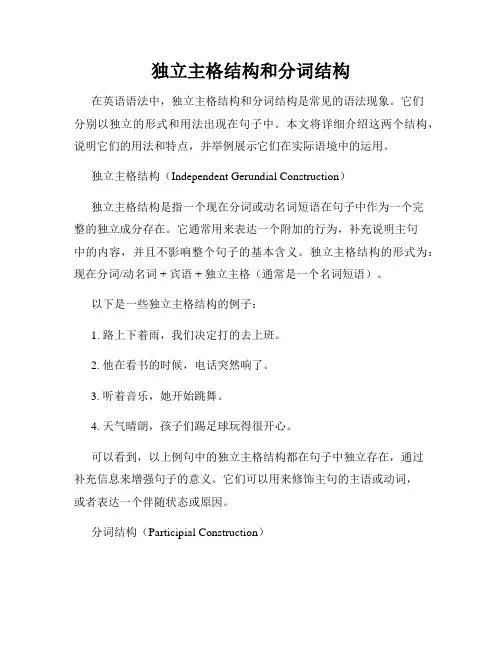
独立主格结构和分词结构在英语语法中,独立主格结构和分词结构是常见的语法现象。
它们分别以独立的形式和用法出现在句子中。
本文将详细介绍这两个结构,说明它们的用法和特点,并举例展示它们在实际语境中的运用。
独立主格结构(Independent Gerundial Construction)独立主格结构是指一个现在分词或动名词短语在句子中作为一个完整的独立成分存在。
它通常用来表达一个附加的行为,补充说明主句中的内容,并且不影响整个句子的基本含义。
独立主格结构的形式为:现在分词/动名词 + 宾语 + 独立主格(通常是一个名词短语)。
以下是一些独立主格结构的例子:1. 路上下着雨,我们决定打的去上班。
2. 他在看书的时候,电话突然响了。
3. 听着音乐,她开始跳舞。
4. 天气晴朗,孩子们踢足球玩得很开心。
可以看到,以上例句中的独立主格结构都在句子中独立存在,通过补充信息来增强句子的意义。
它们可以用来修饰主句的主语或动词,或者表达一个伴随状态或原因。
分词结构(Participial Construction)分词结构是通过分词的形式在句子中充当句子成分的一种短语结构。
分词结构可以是现在分词(-ing形式)或过去分词(-ed或第三人称单数形式)。
分词结构常常用来修饰主语或宾语,并且能够形成定语从句或状语从句。
以下是一些分词结构的例子:1. 坐在沙发上,他看着电视。
2. 这本书是由著名作家写的。
3. 受伤的狗躺在路边。
可以看到,以上例句中的分词结构分别修饰了主语、宾语和介词短语,使得句子更加丰富和详细。
分词结构可以用来表达时间、原因、条件、方式、伴随等多种语义。
总结独立主格结构和分词结构是英语语法中常见的句子结构形式。
独立主格结构通过现在分词/动名词短语的形式在句子中独立存在,补充说明主句中的内容。
而分词结构则通过分词的形式修饰主语或宾语,起到进一步详细描述的作用。
这两个结构都能为句子增添信息,使其更加准确和丰富。
在实际应用中,我们可以根据句子的需要灵活运用独立主格结构和分词结构,以达到精准表达的目的。

独立主格结构的构成与意义独立主格结构是英语中一种常见的句子结构形式,由“名词/代词 +现在分词/过去分词/形容词”构成,用于补充或修饰整个句子的主语或谓语部分。
独立主格结构在句子中可以起到强调、陈述、解释等作用,让语句更加丰富多样并增强表达效果。
一、构成独立主格结构的要点:1. 名词/代词:独立主格结构中的名词/代词通常是和主句的主语不同的个体,用来描述或补充主句的内容。
2. 现在分词/过去分词/形容词:独立主格结构中的动词形式可以是现在分词、过去分词或形容词,用来修饰独立主格结构中的名词/代词。
二、独立主格结构的意义与用法:1. 陈述性:独立主格结构可以用来陈述一个与主句内容相关但是相对独立的事实或情况。
例句1:The weather being nice, we decided to go for a picnic.(由于天气好,我们决定去野餐。
)例句2:Her work finished, she left the office.(工作完成后,她离开了办公室。
)2. 原因性:独立主格结构可以用来说明主句中的动作或情况发生的原因。
例句3:The rain having stopped, we went out for a walk.(由于雨停了,我们出去散步了。
)例句4:The cake being delicious, everyone wanted a second piece.(由于蛋糕很好吃,每个人都想要吃第二块。
)3. 条件性:独立主格结构可以表示条件,说明在特定条件下的结果或情况。
例句5:The road being blocked, we had to find an alternative route.(由于道路被封锁,我们不得不找另一条路。
)例句6:The wind being strong, the event was canceled.(由于风势强劲,该活动被取消了。
)4. 强调性:独立主格结构可以用来强调主句中的某个动作或情况。
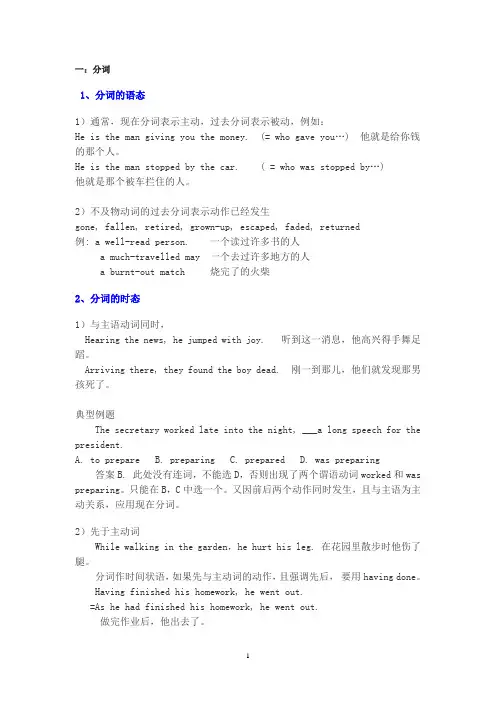
一:分词1、分词的语态1)通常,现在分词表示主动,过去分词表示被动,例如:He is the man giving you the money. (= who gave you…)他就是给你钱的那个人。
He is the man stopped by the car. ( = who was stopped by…)他就是那个被车拦住的人。
2)不及物动词的过去分词表示动作已经发生gone, fallen, retired, grown-up, escaped, faded, returned例: a well-read person. 一个读过许多书的人a much-travelled may 一个去过许多地方的人a burnt-out match 烧完了的火柴2、分词的时态1)与主语动词同时,Hearing the news, he jumped with joy. 听到这一消息,他高兴得手舞足蹈。
Arriving there, they found the boy dead. 刚一到那儿,他们就发现那男孩死了。
典型例题The secretary worked late into the night, ___a long speech for the president.A. to prepareB. preparingC. preparedD. was preparing答案B. 此处没有连词,不能选D,否则出现了两个谓语动词worked和was preparing。
只能在B,C中选一个。
又因前后两个动作同时发生,且与主语为主动关系,应用现在分词。
2)先于主动词While walking in the garden,he hurt his leg. 在花园里散步时他伤了腿。
分词作时间状语,如果先与主动词的动作,且强调先后,要用having done。
Having finished his homework, he went out.=As he had finished his homework, he went out.做完作业后,他出去了。
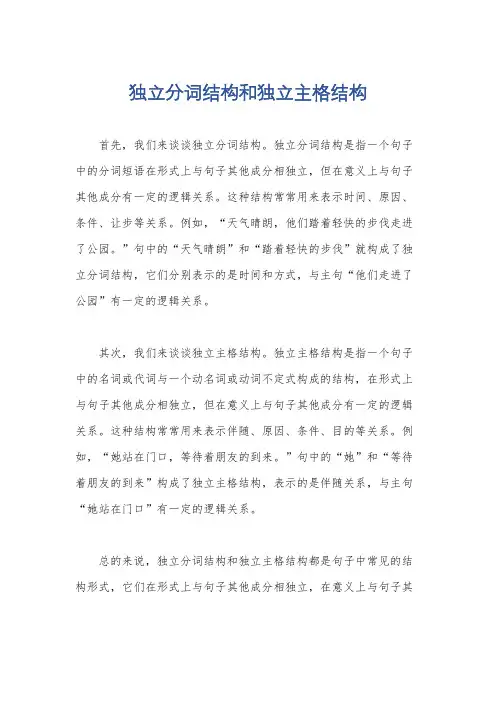
独立分词结构和独立主格结构
首先,我们来谈谈独立分词结构。
独立分词结构是指一个句子中的分词短语在形式上与句子其他成分相独立,但在意义上与句子其他成分有一定的逻辑关系。
这种结构常常用来表示时间、原因、条件、让步等关系。
例如,“天气晴朗,他们踏着轻快的步伐走进了公园。
”句中的“天气晴朗”和“踏着轻快的步伐”就构成了独立分词结构,它们分别表示的是时间和方式,与主句“他们走进了公园”有一定的逻辑关系。
其次,我们来谈谈独立主格结构。
独立主格结构是指一个句子中的名词或代词与一个动名词或动词不定式构成的结构,在形式上与句子其他成分相独立,但在意义上与句子其他成分有一定的逻辑关系。
这种结构常常用来表示伴随、原因、条件、目的等关系。
例如,“她站在门口,等待着朋友的到来。
”句中的“她”和“等待着朋友的到来”构成了独立主格结构,表示的是伴随关系,与主句“她站在门口”有一定的逻辑关系。
总的来说,独立分词结构和独立主格结构都是句子中常见的结构形式,它们在形式上与句子其他成分相独立,在意义上与句子其
他成分有一定的逻辑关系,用来丰富句子的表达,使语言更加生动、丰富。
希望以上解释能够帮助你更好地理解这两种语法结构。
独立主格结构与过去分词作状语的区别在中文语法中,有一些结构和用法可能会让人感到困惑,尤其是在写作中。
其中,独立主格结构和过去分词作状语就是两个易混淆的地方。
本文将深入探讨这两种结构的区别,并且帮助读者更好地理解和运用它们。
1. 独立主格结构独立主格结构是指一个句子中的独立成分,通常由名词或代词与动词的-ing形式构成,用来表示时间、原因、条件、伴随等关系。
其作用是对整个句子进行修饰和补充说明,增加句子的信息量和表达的灵活性。
举个例子:- 雨停了,天晴了,我们整个人都变得轻松起来。
在这个句子中,“天晴了”是主要句子,“雨停了”是独立主格结构,表示时间上的先后关系,并且强调了天气转好后人们的心情也随之改变。
2. 过去分词作状语过去分词作状语是指动词的过去分词形式用来修饰主句或从句,表示时间、原因、条件、方式、结果等。
过去分词作状语通常与所修饰的动词有逻辑上的动宾关系,能够对动作进行修饰和说明。
举个例子:- 他饿了,所以走进了一家餐厅。
在这个句子中,“饿了”是过去分词作状语,表示原因,修饰并解释了他走进餐厅的动作。
过去分词作状语丰富了句子的表达方式,使语言更加生动。
3. 区别与联系独立主格结构和过去分词作状语在形式上有些相似,都是由名词或代词加动词-ing形式构成,而且在句子中都起到修饰和补充的作用。
但它们的使用场景和功能有所不同。
独立主格结构更加独立完整,在句子中可以独立成段,表达一种自成体系的含义。
过去分词作状语则更加依赖于所修饰的动词,是动作的一部分,起到对动作的说明和补充的作用。
4. 个人观点在实际写作中,独立主格结构和过去分词作状语的正确使用可以丰富句子的表达,增加句子的层次感和表现力。
对于作者来说,理解它们的区别和联系,能够帮助我们更好地灵活运用这两种结构,写出具有深度和广度的文章。
对于读者来说,掌握这些语法知识也能够帮助我们更好地理解文章的含义,提升阅读理解能力。
总结回顾通过本文的讨论,我们对独立主格结构和过去分词作状语有了更深入的理解。
Unit 12 独立主格分词作状语时,其逻辑主语往往和谓语动词的主语一致。
有时,分词有自己的主语。
这种带主语的分词结构叫做独立主格结构。
独立主格结构由名词或代词加上其他成分构成,在语法上是一个独立的短语,不是句子,在意思上依附于整个句子,具体有以下特点:1.独立主格结构的作用相当于状语从句,可表示时间、原因、条件、行为方式也可以或伴随状况;2.可置于句首,也可以放在句尾;3.主要用于书面语;4.其逻辑主语与句中语法主语不同,不指同一个人或同一事物。
一.独立主格结构的构成1. 名词/主格代词+现在分词。
名词/主格代词与现在分词之间主谓关系。
如:The girl staring at him (= As the girl stared at him), he didn’t know what to say. 姑娘两眼望着他,他不知道说什么好。
Time permitting (= If time permits), we will go for an outing tomorrow. 如果时间允许的话,我们明天去郊游。
2. 名词/主格代词+过去分词。
名词/主格代词与过去分词之间的动宾关系。
如:The problems solved (= As the problems were solved), the quality has been improved. 随着问题的解决,质量已经提高了。
Her glasses broken (= Because her glasses were broken), she couldn’t see the words on the blackboard. 由于眼镜摔坏了,她看不见黑板上的字。
3. 名词/主格代词+不定式。
名词/主格代词与不定式之间是主谓关系,且强调的是一次具体性的动作。
如:He is going to make a model plane, some old parts to help. 借助于一些旧零件,他要做一个飞机模型。
现在分词和过去分词的意义区别
现在分词和过去分词的时态和语态
分词的功能
现在分词和过去分词的比较
独立主格结构
独立主格结构是由名词或代词加上分词或讽刺短语构成的一种独立结构,用于修饰整个句子,而不是一个词或词组。
独立主格结构中的名词或代词与其后的分词或分词短语构成逻辑上的主谓关系。
这种结构与主句不发生句法上的联系,独立主格结构的位置相当灵活,可置于主句前、主句末或主句中,常有逗号将其与主句分开。
需特别注意的是,独立主格结构与主句之间不能使用任何连接词。
独立主格结构的特点
*(1)当独立主格结构中的being done表示“正在被做”时,being 不可省略。
如:
Supper being prepared,she fell asleep。
她准备晚饭时睡着了。
(2)当独立主格结构的逻辑主语是it,there时,being常不省略。
如:
It being fine,we can enjoy ourselves.
There being no time left, we had to speed up.
剩下的时间不多了,我们只好加快了速度。
非谓语动词独立主格结构
其他形式的独立主格结构。
分词作状语分词和分词短语作状语时,可以表示时间、原因、条件、让步、方式和伴随情况。
在表示时间、原因、条件、让步和方式时,通常可转换为相应的状语从句,表示方式和伴随情况时,可以转换为一个并列的谓语成分。
例如:Seeing the teacher entering the room,the students stood up.(=When the students saw the teacher entering the room,they stood up.)学生们看见老师走进房间,都站了起来。
Heated,ice will be changed into water.(=When it is heated...)当冰加热时,它就会变成水。
(条件、时间)Being excited,I couldn’t go to sleep.(=As I was excited,I couldn’t go to sleep.)我兴奋得睡不着觉。
(原因)I stood there,listening to the broadcast.(=I stood there and listened to the broadcast.)我站在那儿听广播。
(伴随)The children went away laughing.(=The children went away.They laughed as they went.)孩子们笑着走开了。
(行为方式)Knowing all this,they made me pay for the damage.(=Although they know all this...)他们尽管了解这一切,还是要我赔偿损失。
(3)分词作状语与主语的关系。
A. 现在分词作状语时,现在分词的动作就是句子主语的动作,它们之间的关系是主动关系。
例如:He went out shutting the door behind him.他出去后将门随手关上。
现在分词和过去分词的意义区别
现在分词和过去分词的时态和语态
分词的功能
现在分词和过去分词的比较
独立主格结构
独立主格结构是由名词或代词加上分词或讽刺短语构成的一种独立结构,用于修饰整个句子,而不是一个词或词组。
独立主格结构中的名词或代词与其后的分词或分词短语构成逻辑上的主谓关系。
这种结构与主句不发生句法上的联系,独立主格结构的位置相当灵活,可置于主句前、主句末或主句中,常有逗号将其与主句分开。
需特别注意的是,独立主格结构与主句之间不能使用任何连接词。
独立主格结构的特点
*(1)当独立主格结构中的being done表示“正在被做”时,being 不可省略。
如:
Supper being prepared,she fell asleep。
她准备晚饭时睡着了。
(2)当独立主格结构的逻辑主语是it,there时,being常不省略。
如:
It being fine,we can enjoy ourselves.
There being no time left, we had to speed up.
剩下的时间不多了,我们只好加快了速度。
非谓语动词独立主格结构
其他形式的独立主格结构。